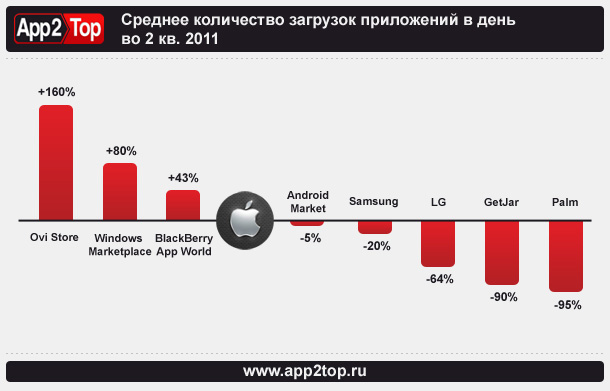The mobile app industry attaches too much importance to the number of downloads. Developers brag about how many times their application has been downloaded, and analysts and owners of online stores consider the number of downloads as the main indicator of success.
Of course, the number of downloads matters, but this figure cannot be considered as an indisputable proof of the victory of an online store or application.
Recently, 2 reports have been published on this topic.
The research2guidance Center for Mobile Research has published a study comparing the average number of app downloads per day in various online stores. The Apple AppStore is taken as a starting point. The report shows that “in the second quarter of 2011, the number of downloads from Nokia’s Ovi Store was 2.5 times more than from the Apple App Store (that is, 160% more downloads per day).
According to the same study, Microsoft’s Windows Marketplace is 80% ahead of Apple’s App Store, and RIM’s BlackBerryApp World is 43% ahead. Google’s Android Market is slightly behind the Apple AppStore (by 5%), while Samsung, LG, GetJar and Palm online stores are far behind the Apple App Store. The data was obtained by dividing the total number of downloads per day by the number of applications. But what do these figures say?
According to research2guidance, the revenue of online stores is a more significant indicator than the number of downloads. Another important factor is how much it costs to develop an application for a particular store.
It is difficult to judge the company’s revenue by the number of downloads. The volume of downloads does not reflect the number of applications sold, but only the potential profit from advertising and payments within applications.
This report should not be considered as propaganda by Apple. Many analysts consider the number of downloads of iOS-based applications without taking into account the number of active users and the revenue of the application. Meanwhile, the facts suggest that although some applications The Apple App Store has a huge number of downloads, many other applications are not downloaded at all.
Another report on this topic was published by the research company Ovum. According to Ovum forecasts, in 2011 Android smartphone apps will be downloaded 8.1 billion times, while iPhone apps will be downloaded only 6 billion times, and by 2016 this gap will increase even more (21.8 billion downloads versus 11.6 billion).
(We have already covered this report on our website)
These sensational figures will certainly cause heated discussions in the coming days. However, the number of downloads again does not give a complete picture of the mobile application sector. So, according to Ovum forecasts, in 2016 the profit from paid applications for the iPhone will amount to $ 2.86 billion, while Android will earn only $ 1.5 billion.
If we translate these figures into profit from one application, we get the following: $0.25 from an iPhone application and only $0.007 from an Android application. The calculations are rather vague, since these figures are obtained by dividing the revenue from paid applications by the total number of paid and free applications. In addition, they do not reflect revenue from advertising and payments within applications.
It can be concluded that the number of downloads without taking into account other factors does not make much sense. Developers and publishers should pay more attention to app revenue and the number of active users. These factors provide a more objective view of the mobile application sector.
For example, the rating of Facebook apps is based on the number of active users per day and per month. The same tactic is followed by the compilers of ratings of mobile social games. As for mobile applications, some research centers, for example, comScore, also evaluate applications by the number of active users. It remains only to wait for developers and publishers of applications to adhere to such a policy.
Apple has released a very important statistic – payments to developers of iOS-based applications, which currently amount to more than $ 2.5 billion. Apple is the only company to release these figures. However, it’s not that simple. It is also necessary to analyze the ratio of paid and free applications, advertising revenue and internal payments in applications, and a lot of other factors.

